Mini-Pre debuts
Sep 9, 2009 — by Eric Brown — from the LinuxDevices Archive — 11 viewsPalm announced the second phone to run its Linux-based WebOS, and cut the price of the Palm Pre by $50. Destined for a fourth-quarter release on Sprint, the Palm Pixi runs a new Qualcomm MSM7627 SoC, and offers a 2.8-inch, 320 x 400 touchscreen, an exposed QWERTY keyboard, and 3G support.
Widely rumored as early as May, weeks before the June launch of the WebOS-based Palm Pre, the Pixi should bring the much touted WebOS experience down to a wider audience. Whereas the Pre runs the Linux-based operating system on an ARM Cortex-A8-based Texas Instruments (TI) OMAP3430 system-on-chip (SoC), the Pixi (below) uses a presumably lesser-powered new version of the ARM-based Qualcomm MSM7xxx line of handset SoCs, called the MSM7267.
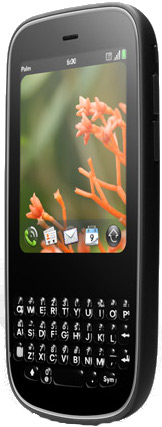
Palm Pixi
The Pixi's memory component appears to be the same as the Pre, offering 8GB of internal storage, of which about 7GB is available for users, says the company. The screen is only slightly smaller than the Pre's, measuring 2.8 inches instead of 3.1 inches, but the resolution drops from 320 x 480 to 320 x 400.
Palm managed to squeeze in a tiny, exposed QWERTY keypad, without using the slide-down mechanism featured on the Pre. It also fits in the Pre's "gesture area," enabling users to implement touch gestures without covering up the screen with their fingers.
While the Pixi is considerably thinner than the Pre, at about 0.4 inches instead of 0.7, the other dimensions are fairly similar, with the Pixi slightly narrower, but taller than the Pre. No talk time estimates were offered for the Pixi's 1150 mAh battery.
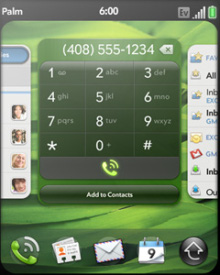

Pixi's WebOS dialing and photo screens
The largest omission compared to the Pre is the lack of WiFi, although the Pixi offers Bluetooth, GPS, and a digital compass, says Palm. The Pixi furnishes a two megapixel fixed-focus camera instead of the Pre's three megapixel model.
The Pixi's sensors include accelerometers, as well as a proximity sensor that is said to save power by disabling the display whenever the phone is placed to one's ear. A light sensor, meanwhile, can be set to dim the display in darker light, such as a movie theater, says Palm. Another nice addition, which like the Pixi's array of sensors, is also available on the Pre, is a ringer switch that silences the phone.
Finally, Palm announced the Palm Pixi Artist Series, a numbered, limited-edition series of optional back covers designed by a variety of artists. These customized covers appear to be available only on the Pixi. (For other hardware comparisons to the Pre, see our original Pre coverage, here.)
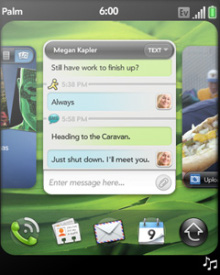
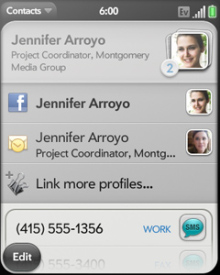
WebOS Palm Synergy messaging multitasking and linked contacts
Palm Synergy offers links to Google, Facebook, and Exchange ActiveSync, and now provides Yahoo! and LinkedIn integration, assembling all the inputs on a single screen, says Palm. For example, all messaging conversations with one person can be assembled in a single chat-style thread (see image above), letting users start a conversation with one IM technology and continuing it on several others. A new Facebook app, meanwhile, is said to let users see and comment on updates in friends's pages, as well as easily update Facebook status from the phone.


WebOS universal search and web browser
The file deletion feature is likely meant as a form of malware protection, says the story, yet could prove controversial, as it would seem to enable a feature somewhat similar to one on the Amazon Kindle that led to a recent controversial misstep by Amazon. The Kindle feature let Amazon reach into the Linux-based devices to delete George Orwell 's "Animal Farm" and "1984" novels, an act for which the company has since apologized (see link at end of story).
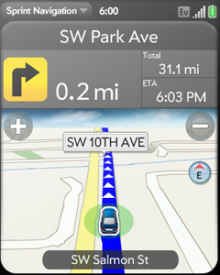
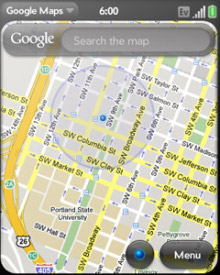
WebOS navigation and Google Maps
- Processor — Qualcomm MSM7627
- Memory — RAM not stated
- Flash — 8GB of internal flash, with about 7GB available to users
- Display — 2.63-inch, 320 x 400 TFT touchscreen with 18-bit color
- Cellular — Dual-band CDMA2000; EVDO Rev. A
- GPS — integrated GPS
- Bluetooth — Bluetooth 2.1 + EDR with A2DP stereo
- USB — MicroUSB connector with USB 2.0 Hi-Speed and USB mass storage mode
- Camera — 2-megapixel fixed-focus with LED flash
- Input — QWERTY keyboard; gesture area
- Sensors — Ambient light; accelerometer; proximity
- Audio — 3.5mm headset jack
- Audio formats — MP3, AAC, AAC+, AMR, QCELP, WAV
- Video formats — MPEG-4, H.263, H.264
- Messaging — IM, SMS, and MMS, supporting Google Talk, AIM, and Yahoo! IM
- Web and email — Web browser, Exchange ActiveSync (EAS), Google push, Yahoo! Push, POP3, IMAP
- Sprint services — Sprint TV, Sprint Radio, Sprint Navigation, NFL Mobile Live, NASCAR Sprint Cup Mobile Live
- Software (WebOS):
- Palm Synergy integration with Facebook, Google, Microsoft Office Outlook, Yahoo! Mail, Google Talk, AIM Instant Messenger, Yahoo! Messenger
- Universal search of applications, contacts, dialing info, web
- Activity card in ROM and from third parties, offering movable, multi-view app cards
- Palm services, including over-the-air backup, restore, remote erase, and software updates
- Battery — 1150 mAh; optional Palm Touchstone Charging Dock
- Dimensions — 2.2 x 4.4 x 0.4 inches (55 x 111 x 10.85mm)
- Weight — 3.5 oz (99.5 g)
- Operating system — Palm WebOS (Linux)
Stated Dan Hesse, CEO at Sprint, "We are pleased to be the first carrier to bring this device to market and offer both devices in the growing Palm webOS family. Sprint's Everything Data plans, which provide unrestricted access to the Internet, mobile content and applications, and our Ready Now retail experience make for a perfect combination with these new Palm products."
Price cut for the Pre
 |
The Palm Pre (pictured at right), which like the Pixi, runs exclusively on Sprint Nextel networks, received a hefty $50 price cut today, announced by Palm and Sprint. It now costs $150 with contract and rebate.
As reported by eWEEK yesterday, Sprint briefly offered — and then revoked — a $100 rebate for the Pre for first-time Pre buyers who were willing to transfer their telephone number from another wireless carrier to Sprint. According to a follow-up story, the company claimed the offer had been posted in error. Presumably, today's $50 price cut for the Pre is for real.
Although pricing hasn't been set for the Pixi, it falls in the same general low-end smartphone category as the HTC Tattoo, a more modest version of the Android-powered HTC Hero that was announced yesterday. Whereas the Hero is also being carried by Sprint, as the carrier announced last week, no carriers have been announced as of yet for the Tattoo, which appears to be headed first to Europe. All these smartphone announcements serve to distract attention from tomorrow's launch by Motorola of its first two Android phones.
Availability
The Palm Pixi is scheduled to be available in the U.S. from Sprint in time for the end-of-year holidays. Pricing will be announced closer to availability. To be notified of the start of pre-registration, users can sign up here, where more information on the phone is also available.
A story on our sister site, eWEEK, focusing more on the Pixi's software features and Pixi Artist Series customizations, may be found here.
Yesterday's original eWEEK story on the short-lived Sprint rebate may be found here, while its follow-up story on Sprint pulling the offer is here. The eWEEK story on Palm's rumored plans for WebOS 1.2 and the new app deletion feature may be found here.
This article was originally published on LinuxDevices.com and has been donated to the open source community by QuinStreet Inc. Please visit LinuxToday.com for up-to-date news and articles about Linux and open source.